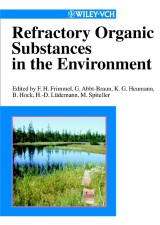Details

Refractory Organic Substances in the Environment
1. Aufl.
|
156,99 € |
|
| Verlag: | Wiley-VCH |
| Format: | |
| Veröffentl.: | 08.01.2008 |
| ISBN/EAN: | 9783527614448 |
| Sprache: | englisch |
| Anzahl Seiten: | 579 |
DRM-geschütztes eBook, Sie benötigen z.B. Adobe Digital Editions und eine Adobe ID zum Lesen.
Beschreibungen
Refractory organic substances (ROS) are an essential part of the biogeochemical carbon cycle. Wherever there is life on earth, there will also be ROS in the form of poorly biodegradable leftovers of organisms and as a source for new life. Furthermore, it is now beyond doubt that ROS are closely related to the carbon intensity identified as one of the driving forces in the dynamics of green house gas emission, such that ROS play a key role in sustainable development. <br> 'Refractory Organic Substances in the Environment' provides the results of six years of top-priority research, funded by the Deutsche Forschungsgemeinschaft (DFG). This research program investigated the structure and function of ROS in different parts of the environment, from a chemical, physical, biological, and soil scientific point of view. It included the first systematic study of a set of reference samples from Central Europe, originating from a bog lake, soil seepage water, groundwater, and from the wastewaters of a brown coal processing plant and a secondary effluent. Thus, this work not only highlights the structural features obtained from the application of advanced analytical tools, but also the function in anthropogenically influenced aquatic systems and soils. Of special interest to students and researchers in life sciences.
Preface <br> List of Authors <br> List of Abbreviations <br> SETTING THE SCENE <br> The Relevance of Reference Materials Isolation and General Characterization <br> Element Determination and its Quality Control in Fractions ofRefractory Organic Substances and the Corresponding Original Water Samples<br> STRUCTURAL INVESTIGATIONS <br> Heavy Metal and Halogen Interactions with Fractions of Refractory Organic Substances Separated by Size-exclusion Chromatography <br> Characterization of Refractory Organic Substances and their Metal Species by Combined Analytical Procedures <br> Application of Nuclear Magnetic Resonance Spectroscopy to Structural Investigations of Refractory Organic Substances -<br> Principles and Definitions <br> Structural Characterization of Refractory Organic Substances by Solid-state High-resolution C-13 and N-15 Nuclear Magnetic Resonance <br> Quantification of Substructures of Refractory Organic Substances by Means of Nuclear Magnetic Resonance <br> Nuclear Magnetic Resonance Spectroscopy Investigations of Silylated Refractory Organic Substances <br> Isotopic Evidence for the Origin and Formation of Refractory Organic Substances <br> Analytical Pyrolysis of Humic Substances and Dissolved Organic Matter in Water <br> Characterization of Refractory Organic Substances by HPLC/MS <br> UV-Visible Spectroscopy and the Potential of Fluorescent Probes <br> Stationary and Time resolved Fluorescence for Refractory Organic Substances Characterization <br> Structural Characterization of Refractory Organic Substances by Pyrolysis-GC/FTIR <br> X-ray Microscopy Studies of Refractory Organic Substances <br> Fractionation of Refractory Organic Substances by Electrophoresis <br> Occurrence of Amino Acids, Carbohydrates, and Low-molecular-weight Organic Acids in Refractory Organic Substances <br> Serological Characterization of Refractory Organic Substances by Serotyping <br> Chemical and Spectroscopic Data of the Reference Samples -<br> Comparison and Evaluation <br> BIOCHEMICAL AND BIOLOGICAL CHARACTERIZATION <br> Formation, Utilization, and Transformation of Some Refractory Organic Substances by Aquatic Microorganisms <br> Effect of Microorganisms on the Formation and Transformation of Iodine Species of Refractory Organic Substances <br> The Influence of Refractory Organic Substances on Bacterial Colonization and Diversity Patterns <br> Influence of Refractory Organic Substances on Enzyme Activity in-vivo and DNA Damage of Aquatic Microorganisms <br> Effects of Dissolved Organic Matter on the Bioconcentration of Organic Contaminants and on Reproduction in Aquatic Invertebrates <br> MOLECULAR INTERACTIONS <br> Sorption of Dissolved Organic Matter on Soil Particles and its Dependence on their Surface-charge Properties <br> Dissolved Organic Carbon in Seepage Water -<br> Production and Transformation During Soil Passage <br> Refractory Organic Substances in Aggregated Forest Soils -<br> Retention versus Translocation <br> Refractory Organic Substances Derived from Organic Amendments in Soil -<br> Formation, Translocation, and Interaction with Xenobiotics <br> Analysis of the Binding of Amitrole and Anilazine to Aquatic and Terrestrial Refractory Organic Substances <br> Sorption and Chemical Reactions of Polycyclic Aromatic Hydrocarbons with Dissolved Refractory Organic Substances and Related Model Polymers <br> Investigation of the Interactions between Polycyclic Aromatic Compounds and Refractory Organic Substances with Stationary and Time-resolved Fluorescence and Absorption Spectroscopy<br>
“…will certainly be of special interest to students and researchers in soil sciences.” (<i>International Journal of Environmental Analytical Chemistry</i>, Vol.84, No.14 – 15, 10 – 20 December 2004)
<p><b>Fritz Hartmann Frimmel</b> is the editor of <i>Refractory Organic Substances in the Environment</i>, published by Wiley.</p> <p><b>Gudrun Abbt-Braun</b> is the editor of <i>Refractory Organic Substances in the Environment</i>, published by Wiley.</p> <p><b>Klaus G. Heumann</b> is the editor of <i>Refractory Organic Substances in the Environment</i>, published by Wiley.</p> <p><b>Berthold Hock</b> is the editor of <i>Refractory Organic Substances in the Environment</i>, published by Wiley.</p> <p><b>Hans-Dietrich Lüdemann</b> is the editor of <i>Refractory Organic Substances in the Environment</i>, published by Wiley.</p> <p><b>Michael Spiteller</b> is the editor of <i>Refractory Organic Substances in the Environment</i>, published by Wiley.</p>
"The proposed organization of subject matter is interesting and unique. Some of the proposed chapter titles sound absolutely fascinating.<br /> —R. Christman, University of North Carolina, Chapel Hill NC, USA <p>"Prof. Frimmel is highly considered in the humic substances research field. Several strong scientists are contributing."<br /> —J. P. Crou, Zoitiers, France<br /> <br /> "This book represents a basic and fundamental report concerning the general and particular aspects on refractory organic substances isolation and analysis technique. It is the most important collection of scientific reports and an encouraging platform for young scientists who wish to devote their careers to addressing the many fascinating and unanswered questions about the properties and roles of refractory organic substances in the environment."<br /> —Carmen Zaharia, Department of Environmental Engineering, "Gh. Asachi" Technical University of Iasi, Romania, <i>Environmental Engineering and Management Journal</i>, March 2004</p>


















